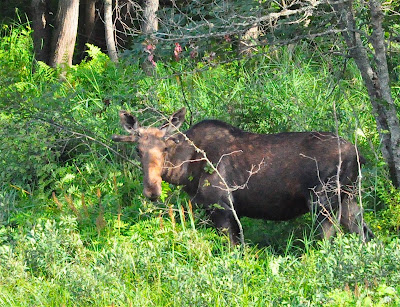 |
| Molly's parents' camp on Lake Placid |
The Adirondack Park in upstate New York is a gem of protected nature and wilderness. It encompasses about a third of New York State's total land mass. [2] It is unique within the United States. The Park was created by the state legislature in 1892 and now comprises about 9,375 square miles (six-million acres) of northern woodlands and lakes. This means the Park is about the size of the state of Vermont and it is three times the size of Yellowstone National Park in Wyoming; in fact it is larger in size than Yellowstone, Everglades, Glacier, and Grand Canyon National Park combined! The park is a combination of both public and private land and more than half of its land mass is privately owned. About 45% of the land has been designated as "forever wild" in the New York state constitution. The private land is committed to 105 towns and villages, farms, businesses, etc. The year round population in the Park is around 130,000 and another 200,000 seasonal residents arrive in the summer. About 10 million people visit the Adirondack Park each year and unlike national parks there are no entrance toll booths and no fees for entering the Park.
The Adirondack Park -- especially in the forever wild areas and in areas that have not been over developed with camps -- has a wide variety of wildlife. Over the years we have seen deer, coyotes, beavers, otters, eagles, black bears, a Great Horned owl, loons, Canada geese, herons, skunks, hawks, and other wildlife too numerous to list here. But, despite the numerous signs such as the one below warning of moose in the area -- and our constant vigilant eyes when in "moosy areas" -- we never saw a moose in the wild . . . until this past August when we visited Molly's sister Kathy who lives in Saranac Lake, NY.
 |
| A typical Adirondack roadside sign warning of moose habit ahead |
When we arrived in the late afternoon, Kathy announced as soon as we pulled into her driveway that a moose had been sighted numerous times in late afternoon feeding in the shallows on the banks of the Saranc River north of the village. She had seen it and so we got back into the cars and went off to finally find and see an Adirondack moose.
It is estimated that there are only between 500 and 700 moose in the entire state of New York, but the only population outside the Park is near Lake Desolation south of Great Sacandaga Lake, which is in the southern-most part of the Park. With that said, sightings of an Adirondack moose are rare and in more than 40 years of trying to see one we failed until this past August! They are out there, but they are basically very shy and not comfortable near human populations. Yet, the greatest danger to the moose is collisions with fast-moving vehicles on roads in the Park. Luckily for us, the five most likely places within the Park to see a moose include the Saranac Lake area (the other four are Vermontville, Limekiln Lake -- Cedar River Road, and Lake Lila).
We drove slowly up along the Saranac River a couple of times and finally on the last pass Kathy spotted the moose. We parked and walked back on the shoulder of the road. I was armed with my digital camera and two telephoto lenses. Below is the result . . . FINALLY! 😊😊
 |
| Three views of the real Adirondack moose in the wild finally caught on camera |
_ _ _ _ _ _ _ _ _ _ _ _ _ _ _ _ _
Copyright 2019, John D. Tew
_ _ _ _ _ _ _ _ _ _ _ _ _ _ _ _ _
[1] In the Adirondacks a lakeside or woodland cabin is often referred to as a "camp" rather than a cottage or even a cabin. The so-called "Great Camps" were not the summer camps for children that we most often think of when talking about camps today. Instead, a Great Camp was a lakeside, grandiose compound of a main residence and associated cabins for guests to sleep in or for other uses. One Great Camp even had an outdoor bowling alley with a roof and open sides. The Great Camps were mostly built in the late 1800s and early 1900s as summer homes for the wealthy to enjoy cooler weather, swimming, boating, fishing and other activities in nature's wilderness areas. [For more info on Great Camps see, https://en.wikipedia.org/wiki/Great_Camps] As the lakes and woods of the Adirondacks developed, just as "a man's home became his castle," the later more modest summer homes on a lake or out in the woods became known as a "camp" rather than a cottage or cabin."
[2] See https://parks.ny.gov/regions/adirondack/default.aspx
_ _ _ _ _ _ _ _ _ _ _ _ _ _ _ _



I enjoyed seeing both the camp (that you've written about in the past) and the moose. A few years ago, while in NH, a group of cars were parked along a road, so we did the same, not knowing what was going on. Yes, it was a moose, in an open field, just trotting alone at a fast pace. Now we don't have to hunt them out for a picture. However, I do hate seeing the signs because I worry about hitting one or getting hit by it.
ReplyDelete